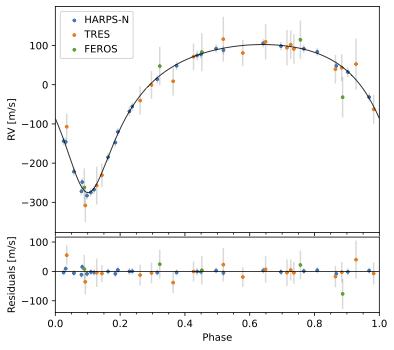HARPS-N helps to characterize the warm Jupiter TOI-4515b
An international team of scientists use HARPS-N data to characterize a planetary system that may shed light into the formation and evolution of warm Jupiters orbiting close to their host stars.
Different theories have been developed to explain the origins and
properties of close-in giant planets, but none of them alone can explain
all of the properties of the warm Jupiters, gas giant extra-solar planets
very similar to Jupiter but with an orbital period between 10 and 200 days.
One of the most intriguing characteristics of these planets is that they
have a wide range of orbital eccentricities, challenging the understanding
of their formation and evolution:the investigation of these systems is
crucial to put constraints on formation and evolution theories. In this
context an accurate radial velocity follow-up of the extra-solar planet
TOI-4515 b has been carried out by an international team as part of the GAPS
project (Global Architecture of Planetary Systems). In particular a joint
analysis of HARPS-N (High Accuracy Radial velocity Planet Searcher in North
hemisphere),TRES (Tillinghast Reflector Echelle Spectrograph), FEROS and
TESS data allowed to fully characterize the planetary system.
The team found that TOI-4515 b orbits its host star (a 1.2 Gyr old G-star
with a metallicity of 0.05) in a very eccentric orbit (0.46) with a period
of ~15 days and that the planet has a mass twice the one of Jupiter, but
with a similar radius. This discovery offers insights into the diverse
formation and dynamical histories of warm Jupiters, and on the mechanisms
responsible for the excitement of their eccentricities.
Considering the slightly metal-rich nature of TOI-4515 b’s host star (∼10%
above solar metallicity), there is the possibility that multiple gas giants
formed within the system. After the gaseous disk dissipated, these gas
giants may have experienced interactions, such as planet-planet scattering
that led to the excitation of TOI-4515 b’s eccentric orbit. This high value
is in the regime of intense chaotic evolution and is suggestive of
catastrophic collisional events.
“Over the past few years GAPS has exploited the remarkable capability of the instruments at TNG, such as HARPS-N, to conduct follow-up observations of TESS candidates. Through our 5-year observing program and the high quality of the data, we have published numerous works enabling us to maintain a leading position in this field and remain competitive on the international stage.” concludes the PI of the paper Ilaria Carleo (Instituto de Astrofísica de Canarias).
Link to the paper.

HARPS-N (blue points), TRES (orange) and FEROS (green) RV data with the overplotted fit from the one of the used theoretical model. See paper for more details.

